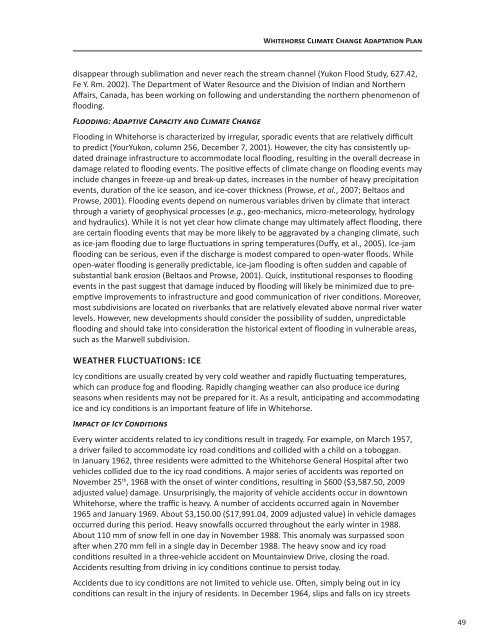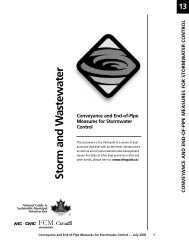Whitehorse Climate Change Adaptation Plan - Yukon College
Whitehorse Climate Change Adaptation Plan - Yukon College
Whitehorse Climate Change Adaptation Plan - Yukon College
Create successful ePaper yourself
Turn your PDF publications into a flip-book with our unique Google optimized e-Paper software.
disappear through sublimation and never reach the stream channel (<strong>Yukon</strong> Flood Study, 627.42,<br />
Fe Y. Rm. 2002). The Department of Water Resource and the Division of Indian and Northern<br />
Affairs, Canada, has been working on following and understanding the northern phenomenon of<br />
flooding.<br />
Flooding: Adaptive Capacity and <strong>Climate</strong> <strong>Change</strong><br />
Flooding in <strong>Whitehorse</strong> is characterized by irregular, sporadic events that are relatively difficult<br />
to predict (Your<strong>Yukon</strong>, column 256, December 7, 2001). However, the city has consistently updated<br />
drainage infrastructure to accommodate local flooding, resulting in the overall decrease in<br />
damage related to flooding events. The positive effects of climate change on flooding events may<br />
include changes in freeze-up and break-up dates, increases in the number of heavy precipitation<br />
events, duration of the ice season, and ice-cover thickness (Prowse, et al., 2007; Beltaos and<br />
Prowse, 2001). Flooding events depend on numerous variables driven by climate that interact<br />
through a variety of geophysical processes (e.g., geo-mechanics, micro-meteorology, hydrology<br />
and hydraulics). While it is not yet clear how climate change may ultimately affect flooding, there<br />
are certain flooding events that may be more likely to be aggravated by a changing climate, such<br />
as ice-jam flooding due to large fluctuations in spring temperatures (Duffy, et al., 2005). Ice-jam<br />
flooding can be serious, even if the discharge is modest compared to open-water floods. While<br />
open-water flooding is generally predictable, ice-jam flooding is often sudden and capable of<br />
substantial bank erosion (Beltaos and Prowse, 2001). Quick, institutional responses to flooding<br />
events in the past suggest that damage induced by flooding will likely be minimized due to preemptive<br />
improvements to infrastructure and good communication of river conditions. Moreover,<br />
most subdivisions are located on riverbanks that are relatively elevated above normal river water<br />
levels. However, new developments should consider the possibility of sudden, unpredictable<br />
flooding and should take into consideration the historical extent of flooding in vulnerable areas,<br />
such as the Marwell subdivision.<br />
WEATHER FLUCTUATIONS: ICE<br />
<strong>Whitehorse</strong> <strong>Climate</strong> <strong>Change</strong> <strong>Adaptation</strong> <strong>Plan</strong><br />
Icy conditions are usually created by very cold weather and rapidly fluctuating temperatures,<br />
which can produce fog and flooding. Rapidly changing weather can also produce ice during<br />
seasons when residents may not be prepared for it. As a result, anticipating and accommodating<br />
ice and icy conditions is an important feature of life in <strong>Whitehorse</strong>.<br />
Impact of Icy Conditions<br />
Every winter accidents related to icy conditions result in tragedy. For example, on March 1957,<br />
a driver failed to accommodate icy road conditions and collided with a child on a toboggan.<br />
In January 1962, three residents were admitted to the <strong>Whitehorse</strong> General Hospital after two<br />
vehicles collided due to the icy road conditions. A major series of accidents was reported on<br />
November 25th , 1968 with the onset of winter conditions, resulting in $600 ($3,587.50, 2009<br />
adjusted value) damage. Unsurprisingly, the majority of vehicle accidents occur in downtown<br />
<strong>Whitehorse</strong>, where the traffic is heavy. A number of accidents occurred again in November<br />
1965 and January 1969. About $3,150.00 ($17,991.04, 2009 adjusted value) in vehicle damages<br />
occurred during this period. Heavy snowfalls occurred throughout the early winter in 1988.<br />
About 110 mm of snow fell in one day in November 1988. This anomaly was surpassed soon<br />
after when 270 mm fell in a single day in December 1988. The heavy snow and icy road<br />
conditions resulted in a three-vehicle accident on Mountainview Drive, closing the road.<br />
Accidents resulting from driving in icy conditions continue to persist today.<br />
Accidents due to icy conditions are not limited to vehicle use. Often, simply being out in icy<br />
conditions can result in the injury of residents. In December 1964, slips and falls on icy streets<br />
49

















